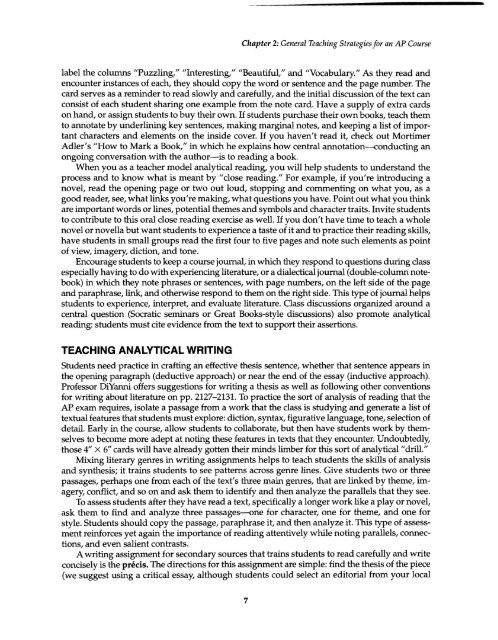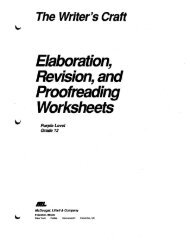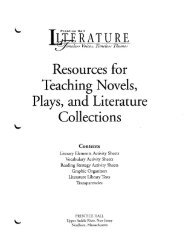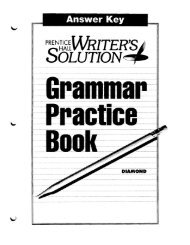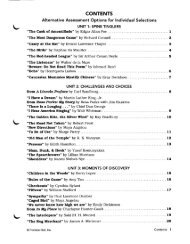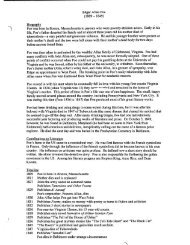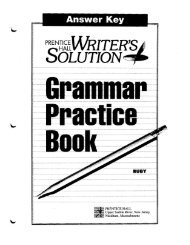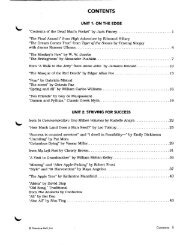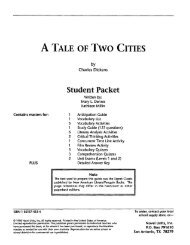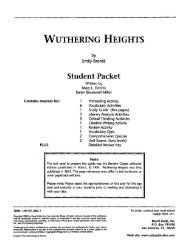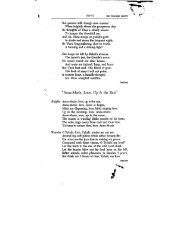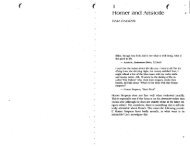English Literature & Composition - PopulationMe.com
English Literature & Composition - PopulationMe.com
English Literature & Composition - PopulationMe.com
You also want an ePaper? Increase the reach of your titles
YUMPU automatically turns print PDFs into web optimized ePapers that Google loves.
Chapter 2: General Teaching Strategies for an AP Course<br />
label the columns "Puzzling," "Interesting," "Beautiful," and "Vocabulary./I As they read and<br />
encounter instances of each, they should copy the word or sentence and the page number. The<br />
card serves as a reminder to read slowly and carefully, and the initial discussion of the text can<br />
consist of each student sharing one example from the note card. Have a supply of extra cards<br />
on hand, or assign students to buy their own. Ifstudents purchase their own books, teach them<br />
to annotate by underlining key sentences, making marginal notes, and keeping a list of important<br />
characters and elements on the inside cover. If you haven't read it, check out Mortimer<br />
Adler's "How to Mark a Book," in which he explains how central annotation-conducting an<br />
ongoing conversation with the author-is to reading a book.<br />
When you as a teacher model analytical reading, you will help students to understand the<br />
process and to know what is meant by "close reading." For example, if you're introducing a<br />
novel, read the opening page or two out loud, stopping and <strong>com</strong>menting on what you, as a<br />
good reader, see, what links you're making, what questions you have. Point out what you think<br />
are important words or lines, potential themes and symbols and character traits. Invite students<br />
to contribute to this oral close reading exercise as well. If you don't have time to teach a whole<br />
novel or novella but want students to experience a taste of it and to practice their reading skills,<br />
have students in small groups read the first four to five pages and note such elements as point<br />
of view, imagery, diction, and tone.<br />
Encourage students to keep a course journal, in which they respond to questions during class<br />
especially having to do with experiencing literature, or a dialectical journal (double-column notebook)<br />
in which they note phrases or sentences, with page numbers, on the left side of the page<br />
and paraphrase, link, and otherwise respond to them on the right side. This type of journal helps<br />
students to experience, interpret, and evaluate literature. Class discussions organized around a<br />
central question (Socratic seminars or Great Books-style discussions) also promote analytical<br />
reading: students must cite evidence from the text to support their assertions.<br />
TEACHING ANALYTICAL WRITING<br />
Students need practice in crafting an effective thesis sentence, whether that sentence appears in<br />
the opening paragraph (deductive approach) or near the end of the essay (inductive approach).<br />
Professor DiYanni offers suggestions for writing a thesis as well as following other conventions<br />
for writing about literature on pp. 2127-2131. To practice the sort of analysis of reading that the<br />
AP exam requires, isolate a passage from a work that the class is studying and generate a list of<br />
textual features that students must explore: diction, syntax, figurative language, tone, selection of<br />
detail. Early in the course, allow students to collaborate, but then have students work by themselves<br />
to be<strong>com</strong>e more adept at noting these features in texts that they encounter. Undoubtedly,<br />
those 4" x 6" cards will have already gotten their minds limber for this sort of analytical "drill."<br />
Mixing literary genres in writing assignments helps to teach students the skills of analysis<br />
and synthesis; it trains students to see patterns across genre lines. Give students two or three<br />
passages, perhaps one from each of the text's three main genres, that are linked by theme, imagery,<br />
conflict, and so on and ask them to identify and then analyze the parallels that they see.<br />
To assess students after they have read a text, specifically a longer work like a play or novel,<br />
ask them to find and analyze three passages-one for character, one for theme, and one for<br />
style. Students should copy the passage, paraphrase it, and then analyze it. This type of assessment<br />
reinforces yet again the importance of reading attentively while noting parallels, connections,<br />
and even salient contrasts.<br />
A writing assignment for secondary sources that trains students to read carefully and write<br />
concisely is the precis. The directions for this assignment are simple: find the thesis of the piece<br />
(we suggest using a critical essay, although students could select an editorial from your local<br />
7


